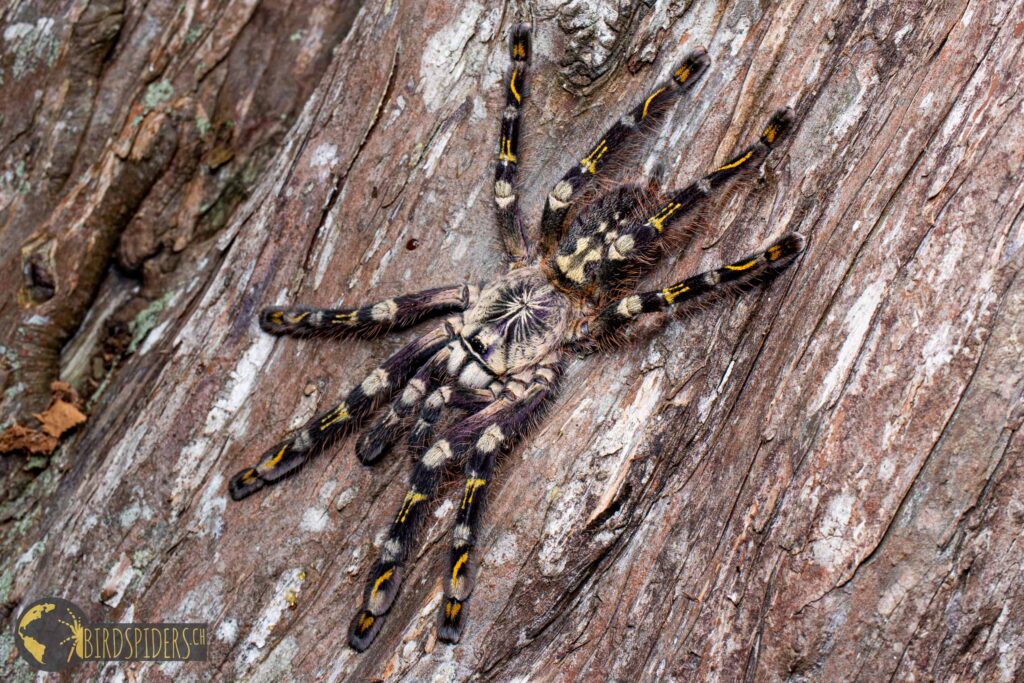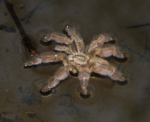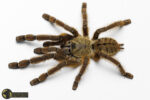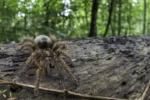Common misconceptions about tarantulas ignore the fact that these creatures are actually rather docile, attractive, and useful. Larger ground-dwelling tarantulas are considered a delicacy in certain cultures around the world, and are therefore caught, cooked, and consumed by humans. The flavor of a cooked tarantula is very close to that of a prawn, as I can attest from personal experience.
Most people still think of tarantulas as the stuff of nightmares and horror flicks. For better or worse, they have come to be identified with the icky, crawly Halloween monsters they resemble. In the medical literature, no human has died from envenomation caused by a bite from any tarantula species. Like other spiders, tarantulas are not aggressive but rather protective, fleeing or fighting back if they feel threatened. Although severe, a tarantula bite can have varying effects on a human, from hardly perceivable pain and edema to a comatose state (extremely rare). Even while scientists have examined the venom of several tarantula species, they still don’t know whether or not any species actually pose a threat to human life. Researchers have discovered, however, that tarantula venom may have use in the treatment of human medical problems like cardiac arrhythmia, Parkinson’s, and Alzheimer’s, as well as agricultural purposes like pesticides.
Tarantulas are the common name given to mygalomorph spiders that belong to the family Theraphosidae. This family of spiders is one of the most well-known and diverse families of arachnids, and it contains some of the largest spider species in the world. The family Theraphosidae is comprised of approximately a thousand different species that are found on every continent other than Antarctica. These species include burrowing, terrestrial, and arboreal taxa that have a wide variety of ecological adaptations and natural histories. Since the family was first described in 1869, their systematics has been mostly dependent on the study of morphological features. Numerous writers are in agreement that the current situation of their taxonomy is extremely chaotic. Morphological characteristics were also used in the initial phylogenetic studies, with molecular research not beginning until the twenty-first century. The vast majority of scholars agree that there are 12–13 subfamilies in the world; the New World is home to five of them.
Poecilotheria subfusca
scientifically described by Pocock, 1895, photograph taken “in situ” by birdspidersCH team in Sri Lanka

There are somewhat more than 900 different species of tarantulas, all of which belong to the mygalomorph family Theraphosidae and are among the largest and most adored of all spiders. When its legs are stretched out in a straight line, the Venezuelan tarantula Theraphosa apophysis (Tinter 1991) can grow to a size somewhat larger than a dinner plate. Females of the South American species Theraphosa blondi (Latreille 1804) are not quite as long-legged, but they do have fangs that can be nearly 2 cm (3/4 inch) in length and an abdomen that can be as big as a tennis ball. Adult Aphonopelma paloma Prentice 1993 tarantulas, discovered in Arizona, have a total body length of just 8 mm (1/3 inch), making them one of the smallest tarantulas in the world.
The majority of Theraphosidae spiders are quite huge and covered in hair. These spiders reside in tunnels, behind stones, or in silken retreats on the ground or on trees and are largely concealed from view. They can be found in caves at depths as low as 800 meters and occupy habitats ranging from sea level to more than 4700 meters (Kaderka, R., Ferretti, N., Hüsser, M., Lüddecke, T. & West, R. 2021). They are most commonly found in tropical and subtropical climates (Mendoza and Francke 2018). Tarantulas are a family of spiders belonging to the Theraphosidae genus. However, this popular word was previously used to refer to wolf spiders as well (Lycosidae). They are also known as araña pollito (bird spider, chicken spider), araña mono (monkey spider), araña pica caballo (horse biting spider), and in Portuguese, aranha caranguejeira or caragueijo. These names are used in various parts of Latin America (crabs- pider). The vast majority of tarantula species are not poisonous spiders, despite their enormous size and intimidating appearance, which contribute to the negative reputation that they have. However, the envenomation effect of the bite is often comparable to that of a wasp sting, despite the fact that the bite can be unpleasant due to the mechanical action of enormous chelicerae. Over the course of the previous few decades, particularly in industrialized nations, the number of people keeping tarantulas as exotic pets has seen a significant uptick.
The fear of spiders, particularly tarantulas, is real for some people and is known as arachnophobia. This phobia is a treatable anxiety problem. In some cases, such as those treated at Stanford University School of Medicine and the University of Washington, patients are encouraged to interact with a live tarantula as part of their therapy.
Let it enough to state that tarantulas have long been viewed with disgust by people of all countries and time periods. However, in the last several decades tarantulas have risen in popularity and are highly sought after as unusual pets.
More and more people are joining “Tarantula Societies” in an effort to get exotic, colorful tarantulas into the pet sector. It is to their credit that several new species of tarantula have been discovered, and that many long-held myths about these spiders have been debunked. Additionally, we now know more about how to better care for, keep, and breed tarantulas in captivity.
The tarantula spider has been associated with gods and goddesses throughout mythology, and some have even attributed religious significance to the creature. Some native communities see tarantulas in general as exceptionally intelligent or crafty tricksters, while others see these ground-dwelling spiders as guards or messengers of the literal pathway between the spiritual underworld and the natural world. It is fascinating to see that people from so many different cultures around the world share the belief that tarantulas, which live in burrows in the ground, protect entrances to the underworld that connect the seeker (shaman) to the spirits of the ancestors.
Venomous spiders of the Lycosa (Wolf spider) and Latrodectus (Widow spider) genera were first discovered near the Italian city of Taranto in the State of Apulia around the 14th century, inspiring the name tarantula. Tarantism is a condition of hysteria and self-hypnosis that people believe is necessary to survive being bitten by one of these spiders. The victim of a Tarantism bite was rumored to develop an uncontrollable need to engage in sexually suggestive dance. The majority of tarantati bite claims in the past were made by women in their late teens, and the vast majority of these occurred during the summer harvest months. A number of women, according to the earliest studies, experienced yearly outbreaks of tarantism on the anniversary of their initial bite. People at the time believed the sickness spread by close contact, and that the only treatment involved playing certain types of music that would cause the infected person to dance provocatively, thereby reducing the effectiveness of the poison. The tarantists’ dances, which could span anywhere from several days to two weeks, were often accompanied by songs with strong sexual content. These dances are today thought to have been a cover for practicing obscene rites forbidden by Christians; at a time of widespread poverty, boredom, and sexual repression in rural communities, it is thought that these rites provided an outlet for pent-up erotic energy. From the 14th to the 17th century, tarantism and the tarantella, in various forms, were popular across the Mediterranean.
An Italian ethnosociologist from the 1950s discovered that tarantism sufferers still visited the chapel and holy spring of St. Paul in Galatina, Italy every June 28 and 29 in the hopes of being cured. St. Paul had been the patron saint of anyone afflicted by tarantula bites in the past. St. Paul was rumored to have dispatched tarantulas after sinners despite his ability to heal those bitten by them. The only traces of tarantism that have survived the advent of television and other cultural shifts are a catchy dance performed at infrequent rural social events and a few musical themes, such as “La Tarantella – Antidotum Tarantulae.”
The enormous hairy mygalomorph spider was commonly referred to as a “tarantula” by the early European settlers who had made their way to the southwest United States. The term “tarantula” now generally refers to any member of the family Theraphosidae that is a mygalomorph spider. This is true wherever that the English language is spoken.
A second common name for a tarantula spider was brought back to Europe from the Far East and Latin America by explorers in the eighteenth and nineteenth centuries. Some of the explorers were naturalists, and they both overstated the size of tarantulas and reported seeing native children walk tarantulas tied to a piece of vine like a “little Pekinese dog on a leash.” Bird-eating spider or bird-spider were common names for the arboreal tarantula.
Maria Sybilla Merian, a German naturalist, published a folio in 1705 titled Metamorphosis Insectorum Surinamensium about the insects of Surinam. Madam Merian reported and drew her first-hand experience of a bird-eating tarantula, likely an Avicularia, in the trees of South America. In an era when males dominated the scientific world, the idea that a spider could trap and consume a bird or that a tarantula could dwell in a tree would have been unthinkable.
Over a century after Madam Merian’s report was published, the idea that spiders might kill birds and consume them grew more plausible. Alexandre Moreau de Jonnes, in his 1817 article for the Bulletin de la Societe Philomathique, reported seeing arboreal Avicularia tarantulas on Martinique and Guadeloupe, where they were eating lizards (Anolis sp. ), hummingbirds (Colibri sp. ), and a tree-creeper bird related. Artists’ interpretations of what was supposedly seen were frequently used to illustrate these tales. W.S. MacLeay, in an attempt to disprove Madam Merian’s story, put a live hummingbird and an Anolis lizard inside the burrow of a ground-dwelling tarantula in 1834. As MacLeay discovered, the tarantula not only ignored the bird, but also fled the burrow, leading him to conclude that the earlier tales of tarantulas devouring birds were erroneous. Naturalist Henry Walter Bates reported seeing Avicularia tarantulas prey on little birds in the Brazilian woods in 1863, and this was recorded in The Naturalist on the River Amazons. It was reported in Annals and Magazine of Natural History by Reginald Pocock in 1899 that a scientist in Borneo had recovered the arboreal bird-spider Phormingochilus tigrinus Pocock 1895 from a nest after the hatchlings had been murdered.
Numerous tarantula species have now been documented consuming frogs, snakes, tiny rodents, and bats, among other small vertebrate things. The explorers who spoke French termed tarantulas “mygales,” while the Germans called them “vogelspinnen” (bird-spider). The term “bird-spider” is now commonly used to describe tarantulas native to Australia, New Zealand, and some areas of South America.
Except for Tasmania, New Zealand, Hawaii, and most of the South Pacific Islands, tarantulas can be found between the 45th latitudes around the world. This is because tarantulas rely on insects for a significant portion of their diet. With the exception of Florida, where the Mexican species Brachypelma vagans Ausserer 1875 has become established, tarantulas are not thought to occur in the United States north of the Red River or east of the Mississippi River.
There are tarantula species that exclusively inhabit trees (arboreal), tarantula species that create their own ground tunnels (fossorial), and tarantula species that are nomadic opportunistic burrowers, making do with whatever cracks, trash, or abandoned burrows they may find. Some tarantula species, such Hapalotremus, have been found at altitudes of up to 15,000 feet, while others, like Aphonopelma, prefer to spend their time in the Mojave Desert, California, at lower elevations. Some tarantulas, like the Mexican genus Hemirrhagus (previously, in part, Spelopelma), have adapted to a blind, eyeless existence in deep, dark limestone tunnels (troglobites).
The fossil of Rosamygale grauvogeli (tarantula) discovered in France in 1992 dates back to the Lower Triassic period, 235-240 million years ago. Ischnocolinopsis acutus Wunderlich 1988, a tarantula spider preserved in Dominican amber dating back to the Miocene period (about 20-23 million years ago), is the earliest tarantula spider ever discovered. There are very few tarantula remains, and no evidence that they existed 65 million years ago, when the dinosaurs lived. However, tarantulas probably did exist before dinosaurs. It’s possible that the aforementioned land areas split off from the mega continent of Gondwanaland before tarantulas got there, like other flightless species that rely on continuity of the land surface for migration. The Hawaiian and many South Pacific islands are not considered part of the separating land masses because they were produced by volcanoes or coral development.
Tarantulas have changed very little since then. They have outlasted numerous predators and climate shifts. Tarantulas’ native environment is being drastically altered by human activities like pesticide use and agricultural, industrial, and urban development.
Up to this point, about 50,000 species of spiders have been described, which have been organized into 128 families (World Spider Catalog 2022). All of them consume carnivorous organisms, and while some of them are experts in the construction of webs, others reside in burrows or are nomadic species that use improvised shelters. There are three suborders that make up the order Araneae, which is comprised of spiders. These suborders are called the Mesothelae, the Araneomorphae, and the Mygalomorphae. The Mesothelae are a tiny group of spiders native to Asia that have an abdomen that is divided into many parts – most well known would be the genus Liphistius. The Araneomorphae family is the biggest group of spiders, accounting for around 90 percent of all species. These spiders are distinguished by the presence of vertical chelicerae that are opposed to one another. The Mygalomorphae family is the sister group to the Araneomorphae family. This family is distinguished by the presence of chelicerae that are aligned parallel to one another.
Stories about Tarantulas in the wild
- Tapinauchenius – Escape Strategy in nature- Blogpost

- Mexican Yucatan Tarantula – Tliltocatl epicureanus

- Aspinochilus rufus

- Goliath Birdeater Spider – Theraphosa blondi

- Xenesthis sp. blue – Colombian Mountain Xenesthis
